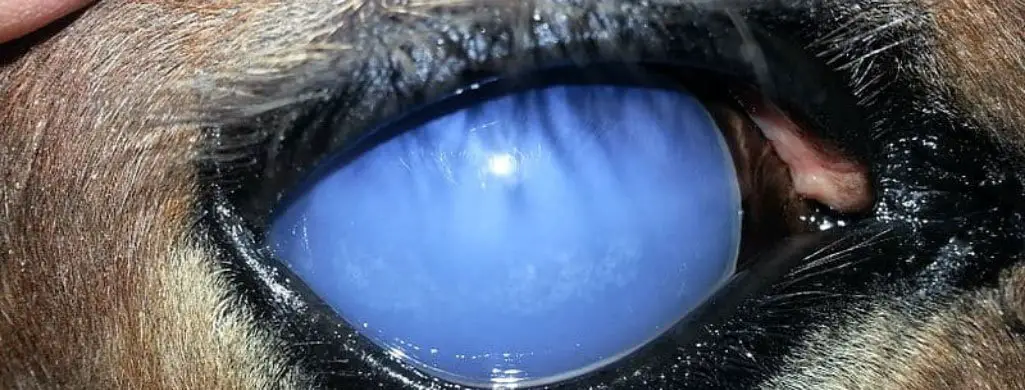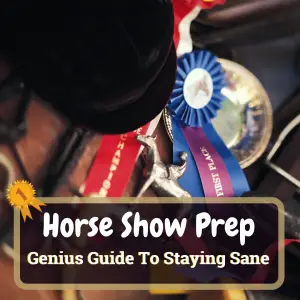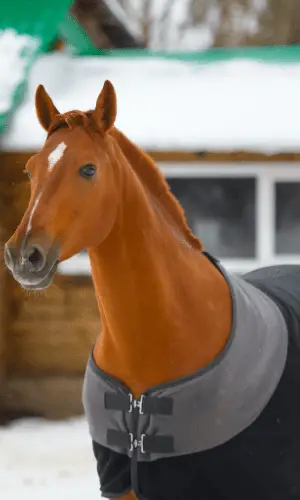
Moon blindness, with its aggressive progressive nature, is a danger to almost 25% of horses in the US. To the many horse shows, I have been to, and for the many horses I have shod, I have encountered several sad cases of this blinding condition. Even more saddening is when an owner fails to notice the symptoms of the disease. What follows next is often a quick deterioration of the animal’s eye health, immense pain, and loss of vision. Worst of all, at an advanced stage, moon blindness can no longer be reversed. The damage is permanent.
[toc]
What is Moon Blindness?
Vets and veterinary ophthalmologists refer to it as Equine Recurrent Uveitis (ERU). The name implies the repetitious nature of the condition that is a deep inflammation inside a horse’s eye. This inflammation is associated with pain and can lead to glaucoma, cataracts, and other forms of eye damage.
The term moon blindness refers to the buffing and fading stages of the condition. Previously, episodes of the disease were related to the phases of the moon, thus the name moon blindness
ERU is characterized by repeated episodes of eye inflammation interrupted by varying periods of clinical inactivity. The condition is one of the most mysterious horse health problems; quite little is known about it regarding cause, treatment, and prevention. There is no cure for it, but strategic clinical management can help to preserve your animal’s eyesight.
Currently, ERU remains the most common cause of blindness in horses. The inflammation often targets the uveal tract of the eye—the latter is the tissue membrane that shields the eye’s inner and sensitive tissues and chambers from the outer layer. The uveal also keeps pathogens carried in the blood from entering the eye’s inner layers that include the retina.
The blood-ocular barrier likewise stops large molecules or blood cells from entering the eye. It keeps away drugs as well and helps to maintain the fluid within the eye clear.
Inflammation or trauma to this protective tissue causes these substances to enter the eye. The result is the formation of antibodies that also attack the eye’s protein layers. An accumulation of antibodies in the eye further heightens the inflammation.
Causes of ERU
Causes of moon blindness are still unknown, but many scientific postulations try to explain its origin and development. These include:
Autoimmune reactions
One of the major suggested causes of equine moon blindness is the inflammatory processes of the structures that make up the uveal tract (iris, choroidal, and ciliary body). Being an immune-mediated disease implies that the horse’s immune system attacks its eye tissues after mistaking them for the disease-causing organisms.
The resultant inflammation and pain may fade away for a few weeks or months, leaving the horse with no apparent symptoms. However, the horse’s cells may continue fighting and attacking the tissue of the eye between episodes of inflammation. That may result in tearing, squinting, and other painful symptoms.
Bacteria
Some researchers believe that moon blindness is an infection resulting from the activity of Leptospira interrogans. The latter is a species of bacteria comprising of over 200 pathogenic serovars. The pathogens trigger the intraocular immune responses that lead to ERU. It’s not the bacterial infection that causes the uveitis, but rather the immune response to the initial infection. Horses contract leptospirosis through contaminated feed or water.
Viral infections
Equine viral infections, including influenza virus and adenovirus, are also classified as causes of moon blindness. However, there is still much uncertainty around these causative agents.
Researchers suppose that due to hypersensitive reactions to viral activities in the eye’s blood-ocular barrier, the horse eventually fails to develop immune tolerance to his eye, thus triggering autoimmune responses.
Allergic reactions
Clinical evidence suggests that inoculations of specific retinal proteins, one known as the S-antigen, can induce the development of allergic uveitis in various animals, including horses.
Parasites
Parasites cause ERU in the same way as bacteria and viruses –they create the breakage of the blood-ocular barrier, thereby resulting in an autoimmune response.
In the past, the major parasite linked to ERU was Onchocerca in its tiny larva form, but that’s no longer the case thanks to ivermectin therapy. However, if ever there are strains of ivermectin–resistant Onchocerca parasites, they could certainly lead to ERU.
Genetics
The Appaloosa breeds have a high higher risk of ERU compared to other races. This predilection points to a genetic basis for moon blindness. If your Appaloosa develops ERU in one eye, chances are the other eye will catch the infection too.
Remember, though, that equine recurrent uveitis is not contagious, meaning that it cannot spread from one horse to another. It affects all horses, regardless of age or sex. The underlying cause for ERU will likely remain controversial and debated for decades to come.
Other suggested causes of moon blindness include:
- Vitamin deficiencies
- Tooth and hoof abscesses
- Physical trauma to the eye
Symptoms of Equine Recurrent Uveitis
The first episode of moon blindness may occur in young horses between four and eight years old. However, not every horse develops a recurrent case of the condition. Vets typically confirm that it’s ERU after two or three episodes of the disease.
I have seen cases of Equine Recurrent Uveitis on both eyes. Generally, if there is no immediate treatment and care for one eye, the other eye may get a similar inflammation later. It makes sense; the same bacterial, viral, or traumatic conditions that cause ERU can still affect the other eye if not identified and rectified.
Signs of ERU include:
Dilation of Vessels
The protective uveal tract contains many blood vessels. Inflammation would, therefore, lead to the dilation of the vessels and visible redness. Ocular fluid may also start to leak, denoting the disruption of the blood-ocular barrier. The presence of blood might also be observed, especially in cases of traumatic uveitis.
In most ERU cases I have seen, the affected eye is teary and swollen. It often seems as if the animal bumped himself onto an obstacle or got hay into his eyes. The horse then quickly recovers, the owners forget about it. But it starts again after a few months.
Each episode brings a progressive worsening of the uveal inflammatory process, increasing the risks for impaired vision.
Squinting
The ocular inflammation in ERU is painful for the animal, and that explains the squinting. The sore, red, and swollen eye membranes would be sensitive even to drought and light. When both eyes are affected, the pupils are smaller than those of healthy horses when examined under the same light conditions.
Cloudiness of eye
Cloudiness of the eye, also known as corneal opacity in an ERU- affected eye, maybe due to corneal ulceration, stromal edema, or neovascularization. Corneal edema (swelling) results from the break in the structural integrity of the corneal epithelium. It pinpoints to the trauma and autoimmune reactions the eye has suffered.
Neovascularization, on the other hand, is the sign of the formation of new blood vessels in the eye area in response to the loss of blood supply in the retina. The new blood vessels are fragile and bleed easily, leading to scar tissues, hence the cloudiness. In severe cases, this could lead to blinding hemorrhages.
Corneal Ulcers
Some horse eyes develop corneal ulcers and other complications that may compel the removal of the eye. The corneal ulcer typically occurs as redness in the eye, pain, discharge, and reduced vision. If the ERU leads to corneal ulcers, it’s an indication that its underlying causes could bacterial infection, fungi, or a parasite that causes severe eye irritation.
Treatment for Moon Blindness
There is no cure for moon blindness, but treatment and care help to reduce uveal inflammation, preserve pupil size and motility, provide pain relief, and prevent the risk of blindness.
After the initial acute episode, which may last several days, a dormant phase follows. The animal does not present clinical signs of ocular inflammation. But vets agree that even during this phase, the uveal inflammatory process continues. Early diagnosis, through a thorough ophthalmic examination, combined with aggressive and disciplined therapy, can significantly reduce the chances of total or partial loss of vision.
The progressive nature of ERU underscores the need for performing periodic examinations during the disease, should you be suspicious of the symptoms you have seen. For confirmed cases of ERU, regular inspections are needed as well to assess treatment efficiency and identify changes in preliminary examinations.
A careful examination of the eyeball is often necessary for both eyes. Remember that inspection may not be easy in animals that have developed an involuntary tight closure of the eyelids. At the slightest touch, such horses become intolerant to manipulation due to intense ERU-related eye discomfort.
Your vet or vet ophthalmologist may use a parenteral sedative or perform an anesthetic blockage of the eyelid’s atrial nerve to help carry out an accurate examination. Other abnormalities on the external eye are often just identified through inspection with an external light source.
For successful treatment of horse moon blindness, consistency is needed from the owner and the vet. A hastened clinical evaluation, with the resulting therapeutic inadequacy, lack of treatment turnout, or even early discontinuation of treatment, often results in higher chances of failures.
Corticosteroids
Corticosteroids can be administered by topical, ocular injections or a combination of the two according to the severity of the condition. The medications lead to inflammation suppression as well as pain relief. But the consistency and route of administration play a significant role in the level of relief obtained from this therapy. Ophthalmic ointments are preferred to eye drops because they have longer contact time with the eye.
Beware, however, that corticosteroids may have unwanted side effects given their immune-suppressing abilities. The medications might leave the horse prone to fungal infections in the eye or even bacterial infections elsewhere, including laminitis in the hooves.
Non-steroidal anti-inflammatory drugs (NSAIDs)
NSAIDs are often widely used in horse clinics and can be helpful for the treatment of uveitis. NSAIDs have a remarkable anti prostaglandin activity (they stop inflammation by constraining the formation of prostaglandins, a group of tissues and lipids that control blood flow and blood clotting at an injury site) and thus minimize potential risks.
Injection or oral administration of NSAIDs may be required to control inflammation. They not only reduce the inflammation of the uveal tract but also reduce the chances of ERU relapses. The three common anti-prostaglandin drugs used in the treatment of ERU include:
- Phenylbutazone – administered orally or intravenously (IV) and used for mild ERU infections.
- Flunixin meglumine – administered orally or IV and used for moderate to severe ERU cases for it has anti-inflammatory, antispasmodic, analgesic, and antipyretic effects.
- Acetylsalicylic acid – I have seen this used with success (at least on condition management level) on recurrent uveitis after treating acute episodes with other drugs.
The biggest challenge for topical steroidal inflammatory drugs is that most have antibiotics in their formulations. In cases of moon blindness unaccompanied by a corneal ulcer, the use of antibiotics may excite uncontrollable fungal growth. Given that they alter the healthy flora of the eye, most vets favor corticosteroids over them.
Immuno-suppressants
Immunosuppressive drugs such as cyclophosphamide can be used to control severe ERU. Cyclophosphamide is the same drug used to prevent organ rejection in patients after a heart or kidney transplant surgery. Cyclophosphamide implants deliver better results than topical administration; the drug has a low ability to penetrate the eye.
Surgical procedures
Your veterinarian may recommend surgical treatment alternatives for your horse’s moon blindness condition. There is inconclusive research on surgical therapies for ERU. Procedures can only be done by experienced ophthalmologists with immense knowledge of the disease and equipped with the latest high-tech tools.
Recovery and Prognosis
Some animals often need long-term non-steroidal anti-inflammatory therapy to maintain eye function and comfort. The chances of vision preservation depend on the frequency and severity of recurrent episodes and the success of the treatment.
If your animal’s cause of ERU was not a perforating kind of trauma, or if it doesn’t have any associated corneal ulcers, there is a good chance for preservation of vision after treatment. Several recurrent episodes and risk of blindness are prognostic for ineffective treatment.
It’s imperative to begin early treatment once you suspect a case of moon blindness. The severity of the condition always advances with each progressive episode. In my experience through years, I can confirm that early diagnosis and treatment for ERU leads to a favorable prognosis.
There are currently many unanswered questions regarding the nature, control, and treatment of ERU. Little is still known. There is ongoing research on new treatment modalities, but confer with your vet (never start treatment for ERU without a vet’s diagnosis), they may advise you on new treatment methods to try.
Currently, early detection of eye changes, together with aggressive and persistent treatment for the symptoms, is the main way to combat the disease. Sadly, (as my farrier duties involve closely working with vets), I have seen many horses referred for examination and treatment at a later stage of the condition, rendering all future therapies highly inefficient. Sometimes when it’s too late, it’s just too late.
Prevention of Moon Blindness
There is little that horse owners can do to prevent Equine Recurrent Uveitis, given its complex and mostly obscure causes. You just don’t know what will cause the condition or what environment will trigger it. Be that as it may, adhering to proper nutrition, and providing a clean environment can certainly help to keep your horse healthy, for ERU is just like any other disease.
Provide good nutrition
Your horse needs a balanced diet comprised of vitamins, proteins, fat, and starch to remain healthy. These nutrients can be found in live grass, hay, or grain feeds. Nonetheless, minerals such as calcium, sulfur, and magnesium are always in trace amounts and may need supplementation. Vets agree that the MSM organic sulfur supplement is an excellent ally in the prevention and management of moon blindness.
Keep environment clean
As mentioned at the start, the suggested causes of ERU include bacteria, fungi, parasites, and viral infections or exposure. You can wipe out these causative agents by maintaining a clean environment in the horse’s sleeping quarters and giving the animal regular sponge baths.
Remove dangerous obstacles to the eye
Sharp objects in the horse’s stall can cause eye trauma that leads to ERU. Clear your animal’s environment of such obstacles, including nails, hooks, and hanging pieces of wood. Remove anything else that can poke or scratch the eyes in the animal’s grazing areas as well.
Call vet at the onset of any eye infections
Early diagnosis and treatment can help to suppress recurrent episodes of ERU. Therefore, soon as you see symptoms of moon blindness, call your vet. They will determine whether it’s a case of ERU or not and implement a therapy that prevents further deterioration of your horse’s eye health.
The bottom line
Moon blindness often needs urgent and immediate medical attention. The condition has several mostly unknown causes. Equine Recurrent Uveitis is also severe and hard to control. Treatment and management are costly, and the disease has a high chance of causing blindness.
Successful treatment and management of ERU require early diagnosis and persistent aggressive therapy after that. Prevention of ERU could be by proper nutrition and supplementation, maintaining a clean environment, and removing dangerous obstacles that could injure the horse’s eye from his environment.








